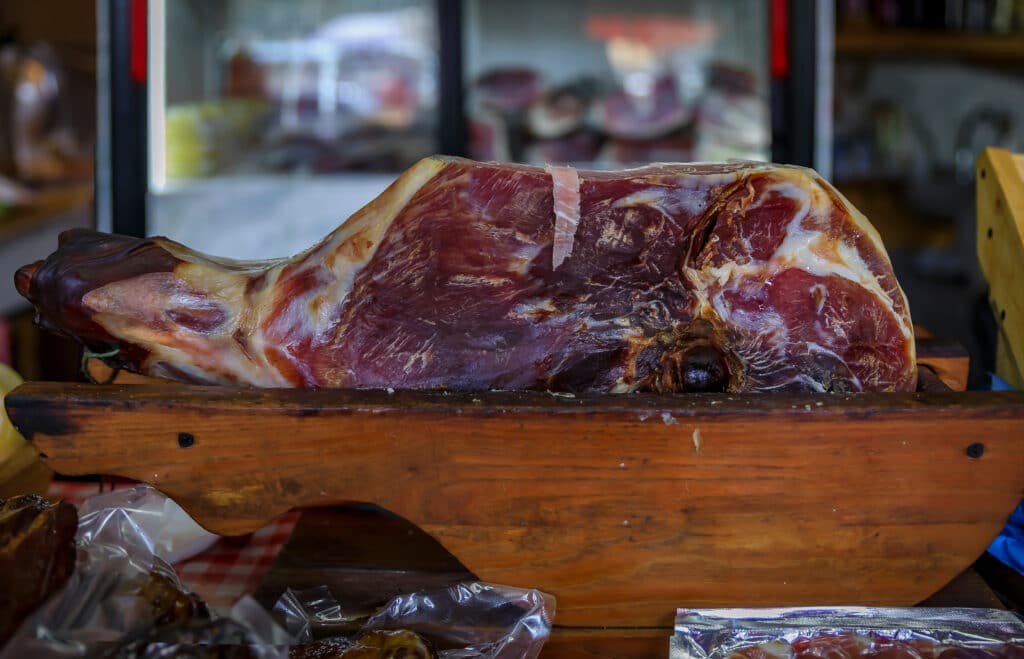Njeguški Pršut, a national dish of Montenegro, is a dry-cured ham that’s well-known and appreciated. It’s not just food—it’s tradition, history, and culture wrapped in one delicious package.
The making of Njeguški Pršut is an art form passed down through generations. The process begins with the selection of quality pork thighs. These are then salted and left to cure in cold storage for several weeks.
After this initial curing period, the hams are hung to air-dry in the mountain air of Njeguši village for up to a year.
Our team at Remitly created this guide for you as part of our series that celebrates the traditional foods of our global customers.
The Making of Njeguški Pršut
The production process is meticulous and time-consuming. Each ham is carefully monitored throughout its curing period to ensure optimal flavor development.
The unique climate conditions—cold winters and warm summers—of Njeguši village play a crucial role in giving Njeguški Pršut its distinctive taste.
After drying, the hams undergo a smoking process using beech wood. This imparts an additional layer of flavor that sets Njeguški Pršut apart from other types of cured ham.

The Taste Profile of Montenegrin Njeguški Pršut
Njeguški Pršut has a complex taste profile that reflects its careful preparation method. It offers a delicate balance between salty and sweet flavors with subtle smoky undertones.
The texture is equally impressive—it’s firm yet tender, melting in your mouth as you savor each bite. Its rich flavor makes it popular among both locals and tourists alike.
Recipe: Preparing a Njeguški Pršut Platter
Creating a Njeguški Pršut platter is an easy way to enjoy this Montenegrin delicacy at home. Here’s how you can prepare it at home.
Ingredients:
- 200 grams of thinly sliced Njeguški Pršut
- 100 grams of Pljevlja cheese (or any other semi-hard cheese)
- A handful of green and black olives
- Freshly baked bread
- A bottle of Vranac wine
Instructions:
- Arrange the slices of Njeguški Pršut on a large serving platter.
- Add chunks or slices of Pljevlja cheese next to the ham.
- Scatter the olives around the platter.
- Serve with freshly baked bread on the side.
- Pour glasses of Vranac wine to accompany the dish.
Remember, enjoying Njeguški Pršut is not just about eating—it’s about savoring each bite and appreciating its rich history and tradition.
History and Origin of Njeguški Prşut
Njeguški Prşut has deep roots in Montenegrin history dating back centuries ago when it was first made by local farmers as a way to preserve meat. It has since become a symbol of Montenegrin culinary heritage.
The village of Njeguši, where the ham is produced, is nestled in the mountains of Montenegro. The unique microclimate here is ideal for curing ham, contributing to its distinctive flavor profile.
Traditional Serving Methods for Njeguški Prşut
Traditionally, Njeguški Prşut is served thinly sliced with a side of cheese and olives. It’s often enjoyed as an appetizer or part of a charcuterie board.
In Montenegro, it’s common to serve this cured ham during special occasions and celebrations. Its presence on the table signifies hospitality and respect for guests.
Variations of Njeguški Prşut Across Montenegro
While the traditional method of making Njeguški Prşut remains largely unchanged, there are slight variations across different regions in Montenegro. Some producers may use different types of wood for smoking or vary the length of curing time.
Regardless of these minor differences, all versions adhere to strict quality standards that maintain the integrity and reputation of this cherished national dish.
Pairing Suggestions for Njeguški Prşut
Njeguški Prşut pairs well with various foods and drinks due to its versatile flavor profile. A popular pairing is with local cheeses—especially those from the same region like Pljevlja cheese.
When it comes to wine pairings, try it with Vranac—a red wine native to Montenegro. The robust flavors complement each other beautifully creating a delightful gastronomic experience.
Influence on Montenegrin Cuisine
Njeguški Prşut has significantly influenced Montenegrin cuisine over centuries. It’s not only used as a standalone dish but also incorporated into various recipes adding depth and complexity to their flavors.
Its influence extends beyond Montenegro’s borders, with many neighboring countries incorporating this cured ham into their culinary traditions. It’s a testament to the enduring appeal of Njeguški Prşut.
Montenegrin Cuisine: A Blend of Traditions
Montenegrin cuisine reflects its diverse cultural heritage and geographical influences. It’s characterized by hearty dishes made from locally sourced ingredients, often featuring meat, dairy products, and fresh produce.
Coastal vs Mountain Cuisine
The coastal areas favor lighter dishes with Mediterranean influences—think seafood, olive oil, citrus fruits, and fresh herbs. In contrast, mountain regions lean towards heavier fare like smoked meats, hearty stews, and robust cheeses.
Staple Dishes
Beyond Njeguški Pršut, other well-known Montenegrin dishes include Kacamak—a comforting polenta-like dish often served with sour milk or cheese—and Burek—a flaky pastry filled with meat or cheese.
Influence of Neighboring Countries
Montenegrin cuisine also shows influences from neighboring countries. Turkish influence is evident in dishes like Cevapi—grilled minced meat sausages—and Baklava—a sweet pastry made with layers of filo filled with chopped nuts and sweetened with syrup or honey.
Montenegrin Wine Culture
Wine plays a significant role in Montenegrin culture. The country produces several indigenous grape varieties, including Vranac, which pairs beautifully with many local dishes.
In conclusion, Montenegrin cuisine offers a rich tapestry of flavors that reflect the country’s diverse cultural heritage and geographical influences. Whether you’re sampling Njeguški Pršut or savoring a hearty Kacamak, each dish tells a story about this fascinating country and its people.
Visit the homepage, download our app, or check out our Help Center to get started.